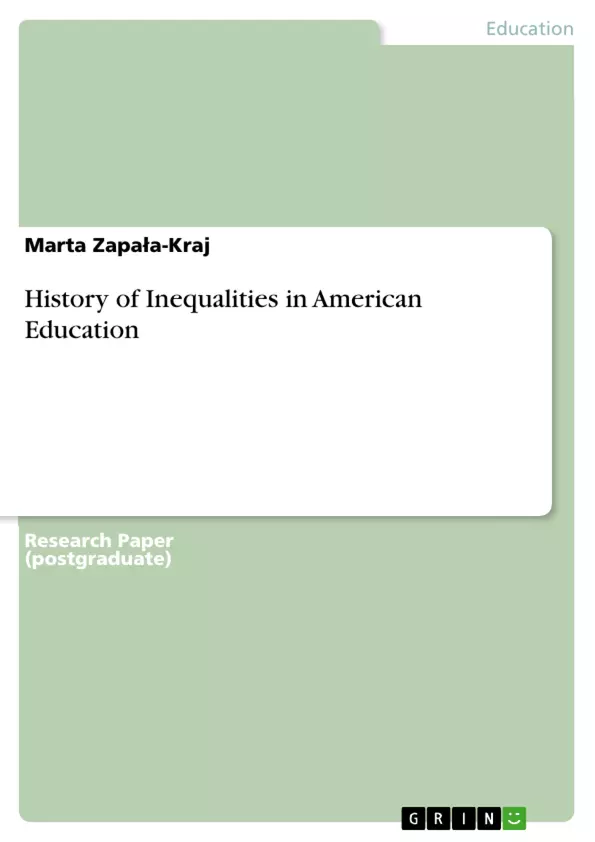Education affects every part of our lives. For the majority of people education level determines income level, place in the class system, and even health. Without quality education in ones youth, he or she is quickly at a severe disadvantage then a peer who receives one. In doing this research the author of this thesis has found the most important obstacles in the history of American education. in order to present what factors led to such a situation in American schools, the author decided to divide the paper in three following parts - each discussing different aspect of inequalities found in educational history.
The problems of education inequality are deeply rooted throughout American history. In the South segregation was upheld in the Supreme Court in the Plessy vs Ferguson Case in 1896 which mandated that schools be segregated into black and white.
What is more, the educational inequalities reach out even deeper - not only did race and skin-color made difference in accesss to knowledge. The sex played also a vital role in it. The history of American education is written down by the numerous minor cases of women who were forbidden to learn, just because they were not born men.
Table of Contents
- Introduction
- Chapter One
- History of American Education – an Introduction to Inequality
- Brief Historical Overview of American Educational System
- The New England - the 'Pure' Minds
- The Southern Colonies
- Educational Reformers at Work
- Disruption in Education
- Urbanization, Industrialization and Immigration as a Turning Point in American Education
- Modern Period
- Public education
- Private Education
- Following World War II
- Chapter Two
- Gender Inequality
- Two Visionaries of Women's Right to Equality
- Plato and The Republic
- Thomas More's Utopia
- Gender Inequality in American Education History
- Revolution - the First Step Towards Women's Education Opportunity
- Common Schools and Gender Inequality Simultaneous Development
- Catharine Beecher - Critical Thinking, Integrated Learning
- Further Steps Towards Equality
- Chapter Three
- Racial Inequality
- The ante-bellum Negroes history of the education
- Effect of the War on Education
- Freedmen and Abandoned Lands - North and The Bureau of Refugees
- African American Education Dispute
- Towards the Decade of the Brown v. Board case
- The South of XIXth century
- The North
- Brown v. Board of Education
Objectives and Key Themes
This research paper explores the historical roots of educational inequality in the United States. The author aims to highlight the systemic challenges faced by marginalized groups, particularly women and African Americans, in accessing quality education throughout American history. The paper examines the historical context, key events, and influential figures that shaped the development of educational disparities. * **Gender Inequality in Education**: The paper examines the historical struggle for women's right to education, from the early ideals of Plato and Thomas More to the challenges faced by women in accessing opportunities in the American educational system. * **Racial Inequality in Education**: The research delves into the impact of racial segregation and discrimination on the education of African Americans, focusing on the antebellum period, the Civil War era, and the landmark Brown v. Board of Education case. * **Historical Context of Educational Inequality**: The paper provides a comprehensive overview of the historical factors that contributed to the persistence of educational inequalities in the United States. * **Impact of Educational Inequalities**: The research explores the lasting effects of educational disparities on marginalized groups, including economic opportunities, social mobility, and overall well-being. * **The Development of the American Educational System**: The paper traces the evolution of the American educational system, highlighting key reforms and movements that aimed to address educational inequalities.Chapter Summaries
Chapter One: History of American Education - an Introduction to Inequality
This chapter provides a historical overview of the American educational system, highlighting the emergence of educational inequalities. It explores the early colonial periods, emphasizing the disparities in educational access between different regions and social groups. The chapter examines the impact of educational reformers, the rise of industrialization, and the role of urbanization in shaping the development of the American educational system.Chapter Two: Gender Inequality
Chapter two delves into the historical struggle for gender equality in education, examining the perspectives of notable thinkers such as Plato and Thomas More. It explores the evolution of women's education in the United States, highlighting key events such as the American Revolution and the emergence of common schools. The chapter also examines the contributions of figures like Catharine Beecher, who advocated for a more integrated and critical approach to women's education.Chapter Three: Racial Inequality
This chapter focuses on the history of racial inequality in American education. It explores the experiences of African Americans in the antebellum period, the impact of the Civil War and Reconstruction era, and the development of segregated school systems in the South. The chapter culminates with an analysis of the landmark Brown v. Board of Education case and the subsequent efforts to desegregate American schools.Keywords
This research paper focuses on the historical development of educational inequalities in the United States, exploring the experiences of women and African Americans in accessing quality education. Key themes include gender inequality, racial inequality, educational access, social mobility, the development of the American educational system, and the impact of historical events on educational disparities. The paper also examines the roles of key figures, including Plato, Thomas More, Catharine Beecher, and various figures involved in the struggle for racial equality in education.- Arbeit zitieren
- MA Marta Zapała-Kraj (Autor:in), 2015, History of Inequalities in American Education, München, GRIN Verlag, https://www.grin.com/document/288321



